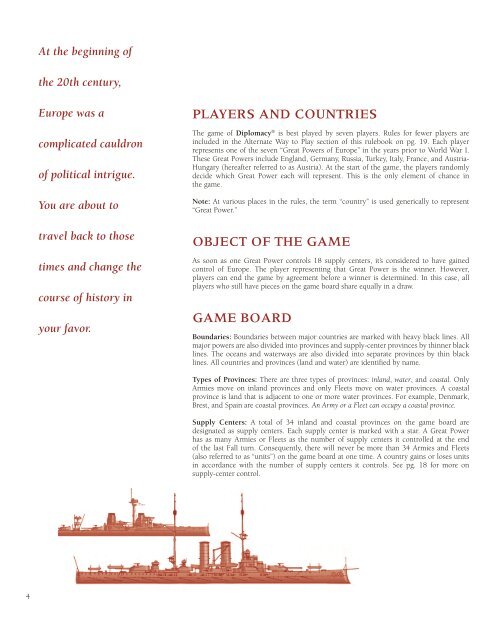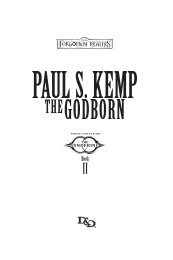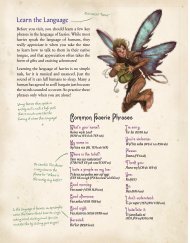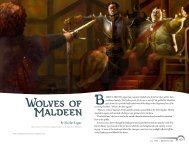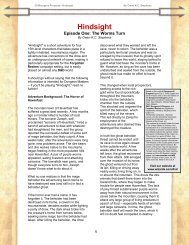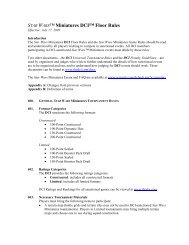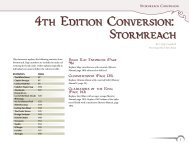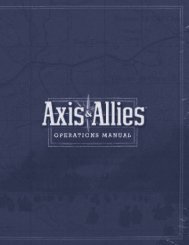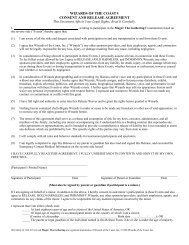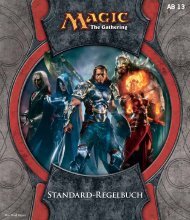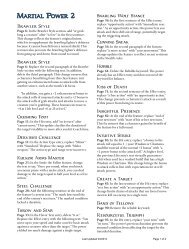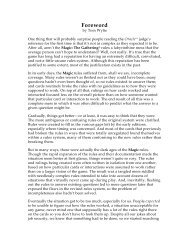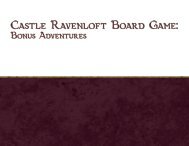Diplomacy Rulebook - Wizards of the Coast
Diplomacy Rulebook - Wizards of the Coast
Diplomacy Rulebook - Wizards of the Coast
Create successful ePaper yourself
Turn your PDF publications into a flip-book with our unique Google optimized e-Paper software.
At <strong>the</strong> beginning <strong>of</strong><br />
<strong>the</strong> 20th century,<br />
Europe was a<br />
complicated cauldron<br />
<strong>of</strong> political intrigue.<br />
You are about to<br />
travel back to those<br />
times and change <strong>the</strong><br />
course <strong>of</strong> history in<br />
your favor.<br />
PLAYERS AND COUNTRIES<br />
The game <strong>of</strong> <strong>Diplomacy</strong> ® is best played by seven players. Rules for fewer players are<br />
included in <strong>the</strong> Alternate Way to Play section <strong>of</strong> this rulebook on pg. 19. Each player<br />
represents one <strong>of</strong> <strong>the</strong> seven “Great Powers <strong>of</strong> Europe” in <strong>the</strong> years prior to World War I.<br />
These Great Powers include England, Germany, Russia, Turkey, Italy, France, and Austria-<br />
Hungary (hereafter referred to as Austria). At <strong>the</strong> start <strong>of</strong> <strong>the</strong> game, <strong>the</strong> players randomly<br />
decide which Great Power each will represent. This is <strong>the</strong> only element <strong>of</strong> chance in<br />
<strong>the</strong> game.<br />
Note: At various places in <strong>the</strong> rules, <strong>the</strong> term “country” is used generically to represent<br />
“Great Power.”<br />
OBJECT OF THE GAME<br />
As soon as one Great Power controls 18 supply centers, it’s considered to have gained<br />
control <strong>of</strong> Europe. The player representing that Great Power is <strong>the</strong> winner. However,<br />
players can end <strong>the</strong> game by agreement before a winner is determined. In this case, all<br />
players who still have pieces on <strong>the</strong> game board share equally in a draw.<br />
GAME BOARD<br />
Boundaries: Boundaries between major countries are marked with heavy black lines. All<br />
major powers are also divided into provinces and supply-center provinces by thinner black<br />
lines. The oceans and waterways are also divided into separate provinces by thin black<br />
lines. All countries and provinces (land and water) are identified by name.<br />
Types <strong>of</strong> Provinces: There are three types <strong>of</strong> provinces: inland, water, and coastal. Only<br />
Armies move on inland provinces and only Fleets move on water provinces. A coastal<br />
province is land that is adjacent to one or more water provinces. For example, Denmark,<br />
Brest, and Spain are coastal provinces. An Army or a Fleet can occupy a coastal province.<br />
Supply Centers: A total <strong>of</strong> 34 inland and coastal provinces on <strong>the</strong> game board are<br />
designated as supply centers. Each supply center is marked with a star. A Great Power<br />
has as many Armies or Fleets as <strong>the</strong> number <strong>of</strong> supply centers it controlled at <strong>the</strong> end<br />
<strong>of</strong> <strong>the</strong> last Fall turn. Consequently, <strong>the</strong>re will never be more than 34 Armies and Fleets<br />
(also referred to as “units”) on <strong>the</strong> game board at one time. A country gains or loses units<br />
in accordance with <strong>the</strong> number <strong>of</strong> supply centers it controls. See pg. 18 for more on<br />
supply-center control.<br />
4


